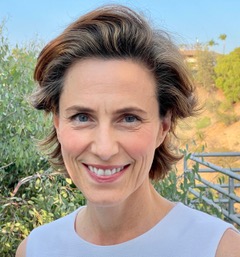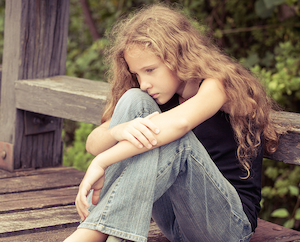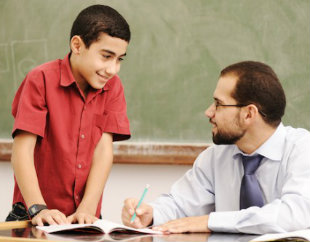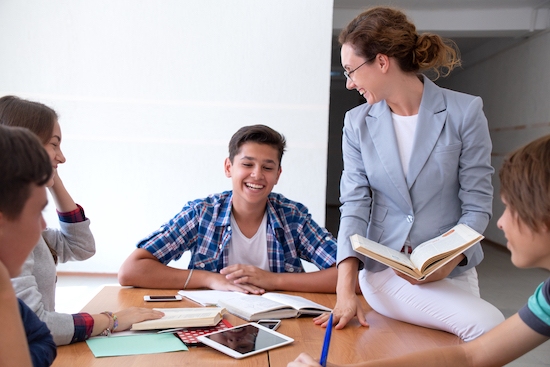Building Relationships with Kids from Day One
By Stephanie Farley
 My first year of teaching, there was a girl in my 7th grade English class who I’ll call Renee. She had freckles, blonde hair, and a snub nose – reminding me, in a cheerful way, of the cartoon kid Dennis the Menace.
My first year of teaching, there was a girl in my 7th grade English class who I’ll call Renee. She had freckles, blonde hair, and a snub nose – reminding me, in a cheerful way, of the cartoon kid Dennis the Menace.
Renee was sad and sassy, brash and deeply insecure. I could see that when I looked at her, but I didn’t really know what to do with it. So, I reasoned, I’d just ignore the suffering I saw in her eyes and try to teach her how to, you know, find meaning in The Outsiders.
I did my best to come up with appealing activities and ways of thinking about the book. But Renee was having none of it. By November of that year, I had completely lost her: she either stared at me, arms crossed, or turned, disinterested, to chat with whoever was near her.
I held her after class one day to talk with her about her work. My attempts to explain her mark of a C on a paper fell flat. She told me I was stupid. I told her that we’d agree to disagree.
She told me that I was a teacher because I couldn’t do other things. I took a deep breath and said that I could do other things and that I’d chosen to be a teacher because I cared! She scoffed and walked out of the room.
Looking back on this incident (which I still remember, 26 years later!), I realize that I failed because:

2. I didn’t try to find out all the wonderful things Renee could do…I just focused on what she lacked.
At the time I talked with other teachers, the dean, and the principal about Renee. But I didn’t talk in a compassionate way to Renee about Renee or give her a chance to shine, which was to my detriment and the detriment of the entire class environment.
We all suffered because of my lack of empathy and knowledge about how to build a relationship with a person who wasn’t like me.
Noticing what was excellent about Joaquin
Some years later, Joaquin was in my 8th grade English class. He loved the drums and constantly tapped out beats with his hands and feet. Joaquin had to move all the time – he spoke really fast, he got bored easily, and he constantly interrupted. But what he had to say was often witty and insightful. He drove my colleagues nuts with his asides and tap tap tapping.
When school started in September, Joaquin told our class that he hated school and planned to bounce when he was 16. I observed Joaquin’s easy, confident manner with other kids, his intellectualism, and his need to move. I also noticed the sadness in his eyes from years of teachers letting him know he was annoying or “bad.”
So I put him in charge of groups, asked him questions that required deeper connections, and made sure the entire class knew that they could sit where they wanted, which also meant they could stand and move around if they wanted.

But most significantly, I made an effort to notice what was excellent about Joaquin – his quick mind, his kindness, his perceptiveness – and to encourage those qualities.
Here’s why I think this worked: Joaquin felt seen and acknowledged by me. He knew that I liked him and wanted him to make progress in class.
Rather than seeing him as a person who fundamentally lacked skills, I reflected back to him all that he could do, which made him want to do more. For my class, he actually completed his work, and he made the revisions I asked him to make.
Joaquin told me – through his writing and to my face – that he did his work for my class because he knew I cared. Honestly, there’s no better feeling as a teacher than feeling like you made a difference for a kid.
As we grow, our relationships with students grow
I’ve had a lot of students like Renee and Joaquin. While I’ve definitely made new mistakes, I’ve not repeated the same mistakes I made with Renee, and I’ve had more successes.
Over the years, I’ve also worked with teachers who really struggle with relationships. They want to understand exactly how one builds a good relationship with every student. Alas, there isn’t a recipe you can follow…my jokes and general silliness as a teacher are utterly mortifying to some of my colleagues, so each teacher has to find their own zone of comfort.
With that being said, here are a few steps you can take to facilitate relationship building.
● Get to know your students. I recognize this is a real “no duh,” but it’s worth repeating! Have them write about themselves in fun ways (i.e., put themselves at the center of a mystery in their house, like “the mystery of my dad’s missing blue sock”), answer questions about themselves, and create projects that highlight their identities. One math teacher I know asks kids their birthdays and then says, “Oh, you’re a prime number” or “Oh, you’re divisible by 3.”
● For students to feel safe enough to show themselves to you, you have to create a welcoming environment that actively demonstrates inclusivity. For me, this has meant allowing kids to read all kinds of stories showcasing a spectrum of identities, rather than the hetero-normative, white, middle-class identity usually represented in “literature.”
One of my 14-year old students gave an end of year speech to the entire school about coming out. She wrote that stumbling across a gay character in a story for my class made her feel as though it was normal and okay for her to be gay. Tears were shed during and after that speech.
I also allow students to choose their own reading material and to write about what appeals to them. This creates a safe space, as each child can use work that engages them as a vehicle for growth.
● Identify each child’s strengths and sing them a song of their excellence instead of their deficits. Let them know you see them and value their contributions. Point out their strengths and try to find a way to publicly hold up every single student and their accomplishments. An easy way to do this is have the kids work on a quick art project that they share with the class. Find what’s good in each of the projects and say it out loud.
● Don’t make a long list of all the “areas for improvement.” Focus on 1 or 2 “growth” areas at a time. Humans don’t get good at stuff by trying to improve everything all at once; rather, we get good when we practice a few things, over and over. If you don’t believe me, watch the Beatles documentary Get Back, in which you’ll see that even acknowledged masters of their craft have to engage in focused practice to improve.
● Create time for getting to know your students through play. Play is a natural and excellent way for students to learn. It’s also an effective way for you to understand more about each person…do they prefer logic and reasoning or a more flexible, creative approach? Can they strategize? Can they gracefully accept loss? Do they collaborate? Work alone? Do they like to make up their own rules? Use this information to craft activities and assignments.
Putting strong relationships at the fore
As writer George Saunders said in his 2013 Syracuse commencement speech, my regrets in life are about “failures of kindness.” I wasn’t actively mean to Renee, but I failed in empathy. And I didn’t see this immediately; it took lots of reflection and years of professional development for me to understand what I could do better.
I still sometimes fail in kindness. However, in my teaching life, my first priority is to establish what is awesome about every kid in my class and to make sure that kid knows it. By putting strong relationships at the fore, I’m cultivating an environment in which each child can grow.
Stephanie Farley has been an English teacher and independent school administrator for 27 years. Interested in instructional design, assessment, feedback, and grading, Stephanie served as a Mastery Transcript Consortium Site Director and has been on a number of California Association of Independent Schools accreditation committees. She has created professional development for schools around reading and curriculum and coaches teachers in instruction, lesson planning, feedback, and assessment. Visit her website Joyful Learning.































